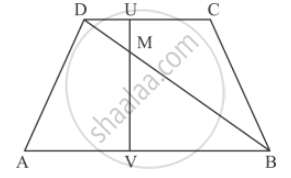Advertisements
Advertisements
Question
D and E are points on the sides AB and AC respectively of a ΔABC. In each of the following cases, determine whether DE║BC or not.
AB = 11.7cm, AC = 11.2cm, BD = 6.5cm and AE = 4.2cm.
Solution
We have:
AB = 11.7 cm, DB = 6.5 cm
Therefore,
AD = 11.7 -6.5 = 5.2 cm
Similarly,
AC = 11.2 cm, AE = 4.2 cm
Therefore,
EC = 11.2 – 4.2 = 7 cm
Now,
`(AD)/(DB)=5.2/6.5=4/5`
`(AE)/(EC)=4.2/7`
Thus,`(AD)/(DB)≠ (AE)/(EC)`
Applying the converse of Thales’ theorem,
We conclude that DE is not parallel to BC.
APPEARS IN
RELATED QUESTIONS
In each of the figures [(i)-(iv)] given below, a line segment is drawn parallel to one side of the triangle and the lengths of certain line-segment are marked. Find the value of x in each of the following :

In each of the figures [(i)-(iv)] given below, a line segment is drawn parallel to one side of the triangle and the lengths of certain line-segment are marked. Find the value of x in each of the following :

In each of the following figures, you find who triangles. Indicate whether the triangles are similar. Give reasons in support of your answer.

In the given figure,

AB || DC prove that
DM × BV = BM ✕ DU
In ∆ABC, given that AB = AC and BD ⊥ AC. Prove that BC2 = 2 AC. CD
If the areas of two similar triangles ABC and PQR are in the ratio 9 : 16 and BC = 4.5 cm, what is the length of QR?
Sides of two similar triangles are in the ratio 4 : 9. Areas of these triangles are in the ratio.
If ∆ABC and ∆DEF are similar such that 2AB = DE and BC = 8 cm, then EF =
XY is drawn parallel to the base BC of a ∆ABC cutting AB at X and AC at Y. If AB = 4 BX and YC = 2 cm, then AY =
If ∆ABC ∼ ∆DEF such that DE = 3 cm, EF = 2 cm, DF = 2.5 cm, BC = 4 cm, then perimeter of ∆ABC is
